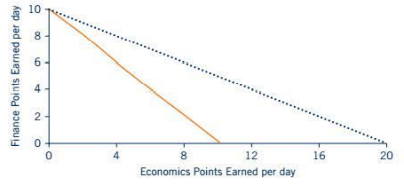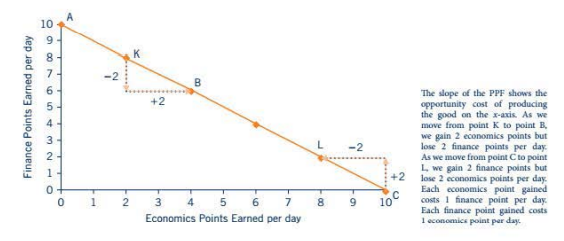
Chapter 2: Production Possibilities
To understand an economy's production possibilities, a model that simplifies the many economic opportunities available is used. Models are used in economics and most other sciences to represent reality.
A model is a simplification that captures the most important features of something but docs not include each and every detail.
The production possibilities model, is one of the most basic and useful models in economics. It describes an economy's potential, it can be used to illustrate how scarcity leads to choices, and it helps us understand that some choices provide more efficient uses of our resources than others.
A prod tells us combinations of goods or services that can be produced by an individual. a group, or an entire economy given the production possibilities model resources available and the state of technology.
A production possibilities frontier(PPF) illustrates the maximum amount of output that can be produced with a given set of resources and technology.
Something is scarce when there is a limited amount of it available but more than one alternative use for it.
Points on or inside the PPF are called attainable choices.
Points outside the PPF are unattainable choices.
Combinations of output that lie on the PPF represent efficient choices.
Combinations of output that lie inside the PPF represent inefficient choices.
When the PPF shifts to the right, you have the ability to produce more than you did before. In the graph, the outward shift of the curve represents economic growth, which is an increase in the amount of output that you can produce.
This economic growth resulted from an increase in the resources available to you. Your PPF could also move outward because of a change in technology.
Technology that generates overall improvements in production possibilities would shift the PPF outward.
If technology increases production possibilities in some goods but not others, the PPF will move differently.
For example:
lets take an experiment where a student reads an economics textbook and a finance textbook.

The solid PPF represents original production possibilities.
The dotted PPF represents production possibilities after a technological innovation that improves your economics understanding but not your finance understanding.
When a technological innovation increases the production of one good but not another, the PPF rotates outward.
The slope of the PPF equals the opportunity cost of producing one more unit of the good measured on the x-axis.

Absolute advantage is the ability to produce something with fewer resources or to produce more with the same resources as another producer.
Comparative advantage is the ability to produce a good or service at a lower opportunity cost than another producer.
Normative economics deals with value judgments and decisions regarding how things should be.
Positive economics is more objective and provides descriptions of how things are.
When individuals or entire economies decide where to produce on the PPF, they are choosing how to allocate scarce resources. In essence, they are answering three basic economic questions: What to produce? How to produce it? For whom to produce? The answers to these basic economic questions determine the allocation of goods and services in the society.
Chapter 2: Production Possibilities
To understand an economy's production possibilities, a model that simplifies the many economic opportunities available is used. Models are used in economics and most other sciences to represent reality.
A model is a simplification that captures the most important features of something but docs not include each and every detail.
The production possibilities model, is one of the most basic and useful models in economics. It describes an economy's potential, it can be used to illustrate how scarcity leads to choices, and it helps us understand that some choices provide more efficient uses of our resources than others.
A prod tells us combinations of goods or services that can be produced by an individual. a group, or an entire economy given the production possibilities model resources available and the state of technology.
A production possibilities frontier(PPF) illustrates the maximum amount of output that can be produced with a given set of resources and technology.
Something is scarce when there is a limited amount of it available but more than one alternative use for it.
Points on or inside the PPF are called attainable choices.
Points outside the PPF are unattainable choices.
Combinations of output that lie on the PPF represent efficient choices.
Combinations of output that lie inside the PPF represent inefficient choices.
When the PPF shifts to the right, you have the ability to produce more than you did before. In the graph, the outward shift of the curve represents economic growth, which is an increase in the amount of output that you can produce.
This economic growth resulted from an increase in the resources available to you. Your PPF could also move outward because of a change in technology.
Technology that generates overall improvements in production possibilities would shift the PPF outward.
If technology increases production possibilities in some goods but not others, the PPF will move differently.
For example:
lets take an experiment where a student reads an economics textbook and a finance textbook.

The solid PPF represents original production possibilities.
The dotted PPF represents production possibilities after a technological innovation that improves your economics understanding but not your finance understanding.
When a technological innovation increases the production of one good but not another, the PPF rotates outward.
The slope of the PPF equals the opportunity cost of producing one more unit of the good measured on the x-axis.

Absolute advantage is the ability to produce something with fewer resources or to produce more with the same resources as another producer.
Comparative advantage is the ability to produce a good or service at a lower opportunity cost than another producer.
Normative economics deals with value judgments and decisions regarding how things should be.
Positive economics is more objective and provides descriptions of how things are.
When individuals or entire economies decide where to produce on the PPF, they are choosing how to allocate scarce resources. In essence, they are answering three basic economic questions: What to produce? How to produce it? For whom to produce? The answers to these basic economic questions determine the allocation of goods and services in the society.
 Knowt
Knowt
